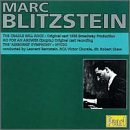| All Artists: Walter Scheff, Marc Blitzstein, Leonard Bernstein, New York City Symphony Orchestra, Charles Holland, Abner Dorsey, Howard da Silva, Norman Green, Martin Wolfson, Blanche Collins, John Adair, Carol Channing, Bert Conway, Curt Conway, Olive Deering, Lloyd Gough, Michael Loring, Coby Rushkin, Norma Green Title: Marc Blitzstein: Musical Theatre Premières Members Wishing: 1 Total Copies: 0 Label: Pearl Release Date: 8/18/1998 Genres: Pop, Classical Styles: Vocal Pop, Opera & Classical Vocal, Symphonies Number of Discs: 2 SwapaCD Credits: 2 UPC: 727031000921 |
Search - Walter Scheff, Marc Blitzstein, Leonard Bernstein :: Marc Blitzstein: Musical Theatre Premières
 | Walter Scheff, Marc Blitzstein, Leonard Bernstein Marc Blitzstein: Musical Theatre Premières Genres: Pop, Classical
|
Larger Image |
CD Details |
CD ReviewsGood historical document, not an exciting perf. or recording Thomas G. Kohn | Dayton, OH USA | 06/02/2000 (2 out of 5 stars) "This recording of The Cradle Will Rock is an important historical recording of the oiginal 1938 Broadway cast. The document presents 56 minutes from the show, leaving something more than half of the performance unknown to today's public. Marc Blitzstein performs at the piano. The recording also presents 37 minutes exerpted from No For An Answer, also performed by its 1940 original cast, and the 3-movement, 13-section Airborne Symphony for orchestra, male chorus, tenor & baritone soli, and narrator. The format of the recording of The Cradle Will Rock is of scenes introduced by a narrator, musical numbers accompanied by piano, and acted portions of the spoken roles. The liner notes claim that most important revivals of the work use these and other no-budget restrictions imposed by the original opening night. In this recording, the performances are played very close to the microphone, and the piano is always relegated to the background. Some performances are shrill or overly arch, especially in the spoken portions. The performances captured on this recording attest to its importance as a pace-setting feat. Unfortunately, the renowned director Orson Welles failed to appreciate a need for rethinking the performances for an audio recording. Some casting seems misguided in matching the voices to the characters they portray, especially in which some older characters are played by voices that seem surprisingly young. The reduction of the book to linking narration matches what one might expect had occurred at the alternate theatre to which cast and audience marched after finding themselves locked out of the WPA Theatre on opening night, 1937. However, the reductions of staging and motivations leave some bits of incongruity that might work well on stage but provide comical images while listening. For example, "Scene 4. The lawn of of Mr. Mister's home. Enter Junior Mister and Sister Mister, each reclining in a hammock." or "The Moll sits quietly on the railing in the half light. She begins to speak, and then she sings." followed by-what else?-the Moll actually speaking, and then actually singing. Scene 2 consists only of the narrative precis of what might be an exciting melange of chorus and soloists. Judging solely from the exerpted product, the book to The Cradle Will Rock expresses everything exactly on the nose, providing little nuance in its polemic. From our perspective more than 60 years distant, the result is a one-dimensional cartoon rather than a persuasive challenge to the status quo. With the lack of revised direction and revulsion toward modifying the stage performance, the music comes across as dated and safe, despite the subject matter. The music and the mileau have some afinity to the music of Dreigroschenoper (Weill/Brecht, 1928), particularly in the incorporation of chorale-inspired melodies for the Mission, scene 3, in the free mixture of popular music genres, and in the occasional love duet. Finally, in addition, nearly every track suffers from an ever-present rain of surface noise from the original disks. The recorded performance of No For An Answer (1940, recorded 1941) retains some of the audience-distancing quirks that Cradle has: accompaniment is still the solo piano, the voices are still placed on top of the microphone, and the document consists of portions of incomplete scenes. At least the narrative precis of action has been discarded. Weirdly, one scene is shuffled from act one to act two, simply to place so-called character sketches together. The performances are uninspired-with one exception being Carol Channing at a less-ripe age and at a nice juxtaposition to most other singers in this recording-and leave little doubt that one may never see a revival of this work. However, the sound quality is much improved from the recording of Cradle, made only 4 years earlier.The Airborne Symphony (1946, and recorded in the same year) is more a cantata than symphony, given the vocal forces and the obvious choice to eschew the forms associated with the symphony. The music and its mixture with theme and speaker (Robert Shaw) are reminiscent of A Lincoln Portrait (Copland, 1942) and, at some points, Richard Rodgers and Roger Sessions. The miking of the performance is again heavily weighted in favor of the speaker and solo voices (Charles Holland, tenor, and Walter Scheff, baritone). The work by conductor Leonard Bernstein is gentle, perhaps too deferential to the soloists and slighted to a great extent because of the miking decisions. The text moves from an opening paean to the flights of Icarus and the Wright brothers (first movement), to a tone painting of flight used to advance war and malefaction (second movement), to a glorification of the British and American forces who were victorious against the mid-20th-Century threats (third movement). One section, "Night Music: Ballad of the Bombardier" is a very nice love song to the flyer's "Emily" back home." Mixed offerings S. J. Headford | 03/31/2007 (3 out of 5 stars) "The CD was ordered for the Airborn Symphony. That piece was exactly what we had been looking for and quite outstanding. The rest of the music on the CD has however been somewhat of a disappointment."
|

 Track Listings (15) - Disc #1
Track Listings (15) - Disc #1